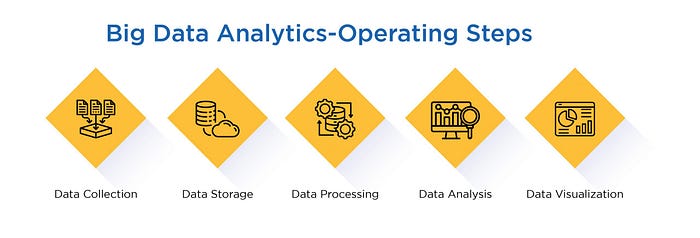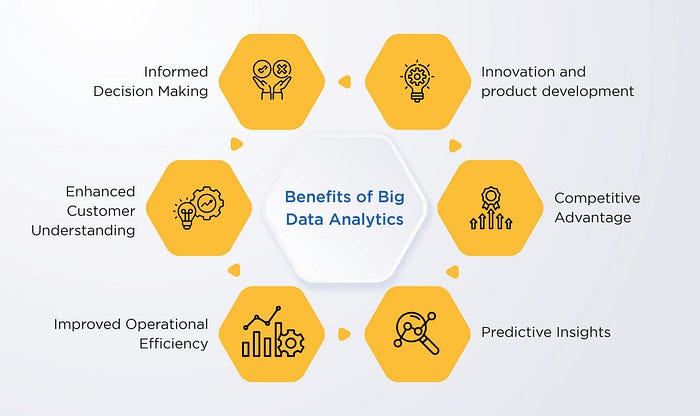Big Data Analytics stands tall as a pivotal asset for businesses aiming to secure a competitive edge. Moreover, a staggering 95% of businesses, irrespective of their size, grapple with the challenge of managing unstructured data. Thus, embracing and comprehending Big Data Analytics isn’t merely a strategic move; it’s a crucial ally for your business.
Through the scrutiny of immense data volumes, companies can not only glean valuable insights into consumer behavior and market trends but also enhance their operational efficiency. From fledgling startups to multinational giants, the comprehension and utilization of Big Data Analytics have become indispensable for informed decision-making and sustainable progress. Let’s delve into its significance, unwrap its advantages, and confront the obstacles it presents. Are you prepared to decipher the data?
Let’s dive in!
Before we dive deeper into the blog kindly take a moment and visit the original post here:
Simplified Guide to Big Data: Analytics, Benefits, Challenges
What is Big Data Analytics?
Big Data Analytics refers to the process of examining large and complex datasets to uncover hidden patterns, correlations, and insights that can inform decision-making and drive business outcomes. At its core, it involves the use of advanced technologies and methodologies to process, analyze, and interpret massive volumes of data that traditional data processing systems cannot handle effectively.
How Big is Big Data?
The sheer magnitude of information generated and consumed globally is staggering. As of 2020, the total amount of data created, captured, copied, and consumed worldwide surged to a monumental 64.2 zettabytes. However, the journey of data expansion is far from over. Projections indicate that over the next five years, by 2025, this figure is expected to skyrocket to an unprecedented 180 zettabytes.
Much of this surge was attributed to the COVID-19 pandemic, which prompted a significant uptick in remote work, online learning, and home entertainment consumption. Consequently, people across the globe generated and consumed data at an unprecedented rate, fueling the surge in global data volumes.
However, despite the astronomical volumes of data generated, only a fraction of it is preserved for future use. This relentless surge in data creation and consumption underscores the critical importance of effective data management strategies and technologies. Using data analytics services businesses can harness the power of Big Data to derive valuable insights, drive innovation, and gain a competitive edge in today’s dynamic digital landscape.
How Does Big Data Analytics Operate?
Big data analytics operates by systematically collecting, processing, and analyzing massive and diverse datasets through advanced computational tools and techniques, ultimately translating raw data into actionable insights that businesses can leverage for informed decision-making and strategic planning.

Data Collection
Big Data Analytics draws information from diverse sources such as social media feeds, sensor data, transaction records, website interactions, and more. These sources contribute to the creation of extensive datasets that serve as the foundation for analysis.
Data is acquired through various techniques including web scraping, APIs (Application Programming Interfaces), data streaming, and IoT (Internet of Things) devices. These techniques enable the continuous influx of data from both structured and unstructured sources.
Data Storage
Data can be stored using different solutions, including cloud-based storage and on-premises solutions. Cloud storage offers scalability, flexibility, and accessibility, while on-premises solutions provide greater control and security.
Data warehousing involves organizing and storing data in a structured format for easy retrieval and analysis. Data warehouses serve as centralized repositories that facilitate efficient data management and analysis.
Data Processing
Data undergoes transformation and cleaning processes to ensure accuracy and consistency. This involves removing duplicate entries, handling missing values, standardizing formats, and resolving inconsistencies.
Data integration involves combining data from multiple sources to create unified datasets. Aggregation techniques are then applied to summarize and condense large volumes of data into manageable subsets for analysis.
Data Analysis
Exploratory Data Analysis (EDA) involves examining data patterns, distributions, and relationships to gain initial insights. EDA techniques include summary statistics, data visualization, and correlation analysis.
Statistical analysis techniques such as regression analysis, hypothesis testing, and clustering are employed to uncover underlying patterns and relationships within the data. Advanced modeling techniques like machine learning algorithms are then applied to predict future outcomes and trends.
Data Visualization
Data visualization plays a crucial role in conveying insights effectively to stakeholders. Visual representations such as charts, graphs, heatmaps, and dashboards enhance understanding and facilitate informed decision-making.
A variety of tools and techniques are available for data visualization, including Tableau, Power BI, Python libraries like Matplotlib and Seaborn, and JavaScript frameworks like D3.js. These tools enable the creation of interactive and insightful visualizations tailored to specific business requirements.
Benefits of Big Data Analytics
There are a myriad of benefits that Big Data Analytics offers to businesses of all sizes and industries:

- Big Data Analytics empowers businesses to make informed decisions based on data-driven insights rather than intuition or guesswork.
- By analyzing large volumes of structured and unstructured data, organizations can identify trends, patterns, and correlations that may have otherwise gone unnoticed. It subsequently enables decision-makers to formulate strategies, allocate resources, and respond to market dynamics with precision and confidence.
Agencies can analyze customer interactions, feedback, and social media activity to gain deep insights into customer needs and preferences. - By segmenting customers based on behavior and demographics, businesses can tailor products, services, and marketing campaigns to target specific customer segments effectively.
- By analyzing operational data, organizations can identify bottlenecks, inefficiencies, and areas for improvement across various departments and functions.
- Businesses can implement process improvements, automate repetitive tasks, and allocate resources more effectively, ultimately reducing costs and increasing profitability. One of the most powerful aspects of Big Data Analytics is its ability to provide predictive insights that enable businesses to anticipate future trends, risks, and opportunities.
- By leveraging machine learning algorithms and predictive modeling techniques, organizations can forecast demand, identify emerging market trends, and mitigate risks before they escalate.
- Big Data Analytics provides businesses with the tools and capabilities to gain unique insights into market dynamics, customer behavior, and competitor strategies. By leveraging these insights, organizations can differentiate their offerings, identify niche markets, and outmaneuver competitors to gain a foothold in the market.
- Businesses can identify gaps in the market and develop innovative products and services that meet evolving customer demands.
- Big Data Analytics fuels innovation and drives product development by providing valuable insights into customer needs, market trends, and emerging technologies. By analyzing customer feedback, market trends, and competitor offerings, This customer-centric approach not only enhances customer satisfaction but also drives revenue growth and market share.
Potential Challenges in Big Data Analytics
While Big Data Analytics offers immense opportunities for businesses to extract valuable insights from vast datasets, it also presents a unique set of challenges that organizations must navigate. Understanding and addressing these challenges is essential for maximizing the effectiveness and efficiency of Big Data Analytics initiatives. Let’s explore some of the potential challenges faced in Big Data Analytics:
Data Quality and Integrity — Ensuring the quality and integrity of data is paramount for accurate analysis and decision-making. Big datasets often contain noise, inconsistencies, and inaccuracies that can skew results and undermine the reliability of insights. Data cleansing and validation processes are essential to identify and rectify errors, anomalies, and missing values, but they can be time-consuming and resource-intensive.
Data Privacy and Security — As organizations collect, store, and analyze increasingly large volumes of data, ensuring data privacy and security becomes a critical concern. Protecting sensitive customer information, intellectual property, and proprietary data from unauthorized access, breaches, and cyberattacks requires robust security measures, encryption techniques, and compliance with regulatory standards such as GDPR and CCPA.
Scalability and Infrastructure — Scaling Big Data Analytics infrastructure to accommodate growing volumes of data and increasing computational requirements can be challenging. Traditional IT architectures may struggle to handle the massive scale and complexity of Big Data Analytics workloads, necessitating investments in scalable storage solutions, distributed computing frameworks, and cloud-based platforms.
Talent and Skills Gap — The demand for skilled data scientists, analysts, and engineers proficient in Big Data Analytics tools and techniques often outpaces the supply. Recruiting and retaining top talent with expertise in data management, statistical analysis, machine learning, and programming languages such as Python and R can be a significant challenge for organizations looking to build and sustain effective Big Data Analytics teams.
Integration and Interoperability — Integrating disparate data sources, systems, and applications to create a unified data ecosystem is a complex and ongoing process. Achieving seamless interoperability between legacy systems, cloud-based platforms, and third-party applications requires careful planning, data governance, and API integration strategies to ensure data consistency, reliability, and accessibility across the organization.
Cost and ROI — Investing in Big Data Analytics initiatives involves substantial upfront costs for infrastructure, software licenses, and talent acquisition. Calculating and demonstrating return on investment (ROI) can be challenging, particularly for long-term projects with uncertain outcomes.
Cultural and Organizational Challenges — Embracing a data-driven culture and fostering organizational buy-in for Big Data Analytics initiatives can be met with resistance and skepticism. Overcoming cultural barriers, siloed thinking, and legacy mindsets requires effective change management, leadership alignment, and stakeholder engagement to instill a culture of collaboration, innovation, and continuous learning.
Ethical and Bias Considerations — Big Data Analytics algorithms and models may inadvertently perpetuate biases, discrimination, and unfair practices if not carefully designed and monitored. Ensuring algorithmic fairness, transparency, and accountability in data-driven decision-making processes is essential to mitigate ethical risks and uphold principles of fairness, equity, and social responsibility.

End Note
Analyzing the vast data in your business is a compulsion now! A mandate that fuels innovation and drives success in today’s competitive landscape. As businesses navigate the complexities of Big Data Analytics, they encounter challenges and opportunities that shape their journey toward data-driven decision-making. At AceInfoway, we understand the importance of harnessing the power of data to gain insights, optimize operations, and drive growth.
As you embark on your data analytics journey, remember that success lies not just in collecting data, but in extracting meaningful insights and taking decisive actions based on those insights.
With our comprehensive data analytics services, powered by cutting-edge tools and backed by a commitment to customer satisfaction, we stand ready to support your organization’s data-driven initiatives. Unlock our partnership in achieving the full potential of your data and transforming your business into a beacon of innovation and success.


No comments yet